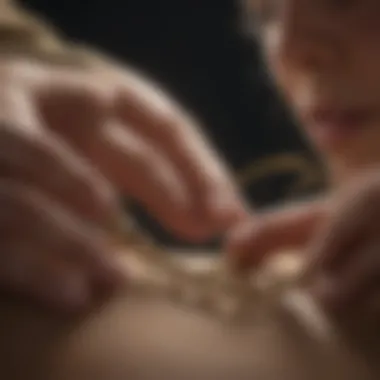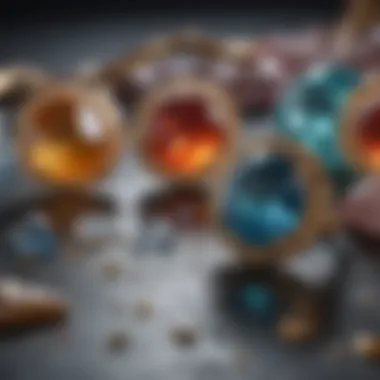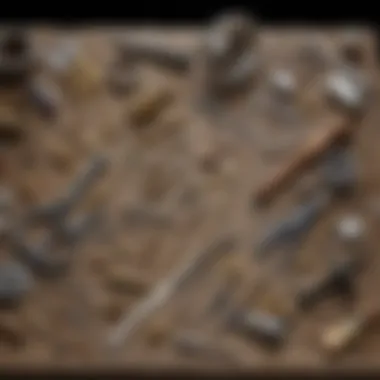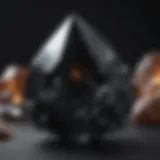Expert Tips for Choosing the Perfect Jewelry Glue


Rock and Fossil Identification
When it comes to jewelry making, understanding the types of adhesives available is critical to ensuring the longevity and durability of your pieces. Similar to rock and fossil identification in the scientific realm, different types of glue serve different purposes in jewelry crafting. Just as geologists identify rocks and fossils based on specific characteristics, jewelry makers must consider the properties of each adhesive to determine the best fit for their project. Tools such as precision applicators, magnifying glasses, and UV lights can assist in identifying the right glue for the specific materials being used in the jewelry piece.
Types of Jewelry Adhesives
Within the realm of jewelry making, several types of adhesives are commonly used to secure gemstones, metals, and beads. These include cyanoacrylate glue (commonly known as super glue), epoxy resin, clear-drying glue, and specialized jewelry adhesives. Each type offers unique advantages and considerations, such as quick drying time, flexibility, or specific compatibility with certain materials. Understanding the properties and applications of each adhesive type is essential for choosing the most suitable option for your jewelry making projects.
Factors to Consider
When selecting the best glue for jewelry making, several factors should be taken into account. These include the type of materials being bonded, the desired strength of the adhesive bond, the working time available before the glue sets, and any special considerations such as temperature resistance or waterproof properties. By evaluating these factors carefully, jewelry makers can make informed decisions when choosing the optimal adhesive for their specific project requirements.
Application Techniques
Applying glue in jewelry making requires precision and care to ensure secure bonds and professional-looking results. Techniques such as using fine-tipped applicators, dispensing the right amount of adhesive, and allowing adequate drying time are crucial for successful bonding. Proper surface preparation, including cleaning and roughening the bonding surfaces, can also enhance the effectiveness of the adhesive. Additionally, understanding curing times and curing conditions can significantly impact the quality and durability of the bond in jewelry pieces.
Testing and Quality Assurance
Before finalizing a jewelry piece, thorough testing of the adhesive bond is essential to confirm its strength and durability. Performing tests such as stress tests, exposure to varied conditions (e.g., heat, water), and long-term wear simulations can help identify any potential weaknesses in the bonding. Quality assurance measures ensure that the glue selected meets the necessary standards for jewelry making and guarantees the longevity of the crafted pieces.
Conclusion
Choosing the best glue for jewelry making is a meticulous process that requires careful consideration of adhesive types, material characteristics, application techniques, and testing procedures. By arming themselves with knowledge about the various adhesives available and employing best practices in application and testing, jewelry makers can elevate the quality and reliability of their creations. With a keen eye for detail and a commitment to excellence, selecting the right glue becomes an integral part of the artistry and craftsmanship involved in producing exquisite jewelry pieces.
Introduction
Jewelry making is a delicate art that requires precision and attention to detail. The choice of adhesive plays a crucial role in the success of any jewelry project, as improper bonding can lead to damage or even loss of precious gemstones and metals. In this comprehensive guide, we will unravel the importance of selecting the best glue for jewelry making, catering to the needs of both beginners and experienced artisans. Understanding the intricacies of adhesive selection is paramount in achieving not only aesthetically pleasing jewelry but also ensuring its longevity and durability.
Moreover, the adhesive used in jewelry making not only serves a functional purpose but also contributes to the overall design and quality of the piece. By delving into the various types of adhesives available and their specific applications, readers will gain valuable insights into how different glues interact with various materials. This insight is invaluable in making informed decisions that will elevate the craftsmanship and longevity of your jewelry creations.
Throughout this guide, we will explore the intricate world of jewelry making, shedding light on common challenges faced by jewelry craftsmen and showcasing the best practices for adhesive application. Whether you are a hobbyist seeking to enhance your skills or a professional jeweler aiming to refine your techniques, this guide will serve as a beacon of knowledge, equipping you with the expertise needed to navigate the diverse landscape of adhesives in the realm of jewelry making.


Understanding the Importance of Quality Adhesives
In the realm of jewelry making, the significance of quality adhesives cannot be overstated. Crafting exquisite jewelry pieces requires not only creativity but also precision and durability in holding together various components. Utilizing superior adhesives ensures that gemstones, metals, and embellishments are securely bonded, enhancing the longevity and visual appeal of the final product. The choice of adhesive can impact the overall aesthetic and structural integrity of the jewelry piece, making it a critical decision in the crafting process.
Factors to Consider When Choosing Glue for Jewelry Making
Type of Materials
When selecting glue for jewelry making, the type of materials being used plays a pivotal role. Different adhesives are suited for specific materials, such as metal, gemstones, glass, or beads. Understanding the compatibility between adhesive types and materials is essential for achieving strong and lasting bonds. Factors like the porosity and texture of the materials influence the adhesive's effectiveness, making it imperative to choose the appropriate adhesive for the specific components being assembled.
Durability
Durability is a crucial factor to consider when choosing glue for jewelry making. The adhesive must withstand everyday wear and tear, ensuring that the jewelry piece remains intact over time. Factors like flexibility and resistance to environmental elements play a role in determining the durability of the adhesive. Opting for adhesives with high durability ensures that the jewelry piece maintains its quality and structural integrity despite continuous use.
Drying Time
The drying time of the adhesive is an important consideration, especially in jewelry making where precision and efficiency are key. Fast-drying adhesives facilitate a quicker assembly process, allowing crafters to work on multiple components without prolonged waiting times. However, it is crucial to balance drying time with workability to ensure precise positioning of elements before the adhesive sets. Finding the right balance between rapid drying and manipulability is essential for a smooth and efficient jewelry-making process.
Transparency
Transparency in adhesives is essential for jewelry making, particularly when working with delicate or transparent materials. Clear adhesives provide a seamless finish, ensuring that the bond is discreet and does not affect the overall aesthetics of the jewelry piece. Transparency also allows crafters to monitor the adhesive application and alignment of components, ensuring accurate and professional results in the final product.
Precision Application
Precision application of glue is critical in achieving intricate designs and detailed work in jewelry making. Adhesives with precise applicators or tips enable crafters to control the amount and placement of the adhesive with accuracy. This feature is especially beneficial when working with small components or intricate designs that require meticulous bonding. Precision application enhances the overall quality and craftsmanship of the jewelry piece, elevating it from amateur to professional standards.
Types of Glue Suitable for Jewelry Making
When it comes to creating exquisite jewelry pieces, the choice of adhesive plays a pivotal role in ensuring the longevity and quality of the final product. Selecting the right type of glue is crucial for bonding metals, gemstones, and embellishments securely. Understanding the different options available for jewelry making can greatly impact the success of your projects. In this section, we will explore the various types of adhesives suitable for jewelry making, covering epoxy resin adhesives, cyanoacrylate adhesives (super glue), and jewelry-specific adhesives.
Epoxy Resin Adhesives


Epoxy resin adhesives are renowned for their exceptional bonding strength and versatility in jewelry making. The benefits and applications of epoxy resins are vast, making them a popular choice among crafters and artisans. Epoxy resin adhesives offer superior adhesion to various materials, including metals, gemstones, and plastics, ensuring a durable and reliable bond. The key characteristic of epoxy resin adhesives lies in their ability to provide a strong, permanent bond that can withstand daily wear and tear.
When it comes to best practices for using epoxy resin adhesives in jewelry making, proper application techniques are essential. Ensuring that the surfaces are clean and free from debris, mixing the epoxy components accurately, and allowing adequate curing time are crucial steps to achieve optimal bonding results. By following best practices, crafters can harness the full potential of epoxy resin adhesives for their jewelry creations.
Cyanoacrylate Adhesives (Super Glue)
Cyanoacrylate adhesives, commonly known as super glue, are another popular choice for jewelry making due to their quick-drying and strong bonding properties. The pros of using cyanoacrylate adhesives include fast curing times, excellent transparency, and high bond strength. However, one of the cons to consider is their potential to cause skin irritation, so proper handling and ventilation are necessary when working with super glue.
Tips for effective application of cyanoacrylate adhesives involve using the right amount of adhesive for the specific materials being bonded, working in a well-ventilated area to avoid inhaling fumes, and ensuring precise alignment before the glue sets. With careful application and attention to detail, cyanoacrylate adhesives can provide reliable bonds for a variety of jewelry components.
Jewelry-specific Adhesives
In addition to epoxy resin and cyanoacrylate adhesives, there are specialized adhesives designed specifically for jewelry making. These adhesives often feature unique formulations that cater to the requirements of attaching gemstones, securing clasps, and bonding intricate components. The features and recommendations of jewelry-specific adhesives vary based on the intended application, with some offering flexibility for resizing jewelry pieces and others providing high-temperature resistance for soldering processes.
Crafters can benefit from exploring the specific features of jewelry adhesives to select the most suitable option for their projects. By understanding the different attributes and recommendations associated with jewelry-specific adhesives, artisans can enhance the quality and craftsmanship of their jewelry creations.
Application Techniques for Jewelry Gluing
The Application Techniques for Jewelry Gluing section holds paramount importance in this comprehensive guide to choosing the best glue for jewelry making. Understanding the proper application techniques is crucial to ensure the effective bonding of various materials in jewelry crafting. By mastering these techniques, jewelry makers can elevate the quality and longevity of their creations significantly.
Surface Preparation
Cleaning Methods
Cleaning Methods play a pivotal role in the jewelry making process, as they contribute directly to the adhesive's ability to form a strong bond. Utilizing appropriate cleaning methods ensures that the surfaces are free from any contaminants, oils, or residues that could hinder the adhesion process. This thorough cleaning step enhances the overall integrity and durability of the jewelry piece. One key characteristic of Cleaning Methods is their ability to prepare surfaces for optimal adhesion, promoting a secure and long-lasting bond. Despite the meticulous nature of Cleaning Methods, their meticulous application proves to be advantageous in achieving flawless jewelry pieces. The unique feature of Cleaning Methods lies in their precision in removing minute particles, guaranteeing a pristine surface for adhesive application.
Priming Surfaces
Priming Surfaces is another essential step in surface preparation before applying adhesives in jewelry making. Priming surfaces help create a suitable foundation for the adhesive to adhere to, increasing the bond strength and overall durability of the jewelry piece. The key characteristic of Priming Surfaces lies in their capacity to enhance adhesion between dissimilar materials, promoting a seamless and secure bond. This preparatory step is a popular choice in jewelry making due to its ability to improve adhesion performance, particularly on challenging surfaces. The unique feature of Priming Surfaces is their compatibility with a wide range of materials, offering versatility in jewelry crafting applications.
Proper Glue Dispensing


Dos and Don'ts
Understanding the Dos and Don'ts of proper glue dispensing is crucial for ensuring successful jewelry bonding. Adhering to recommended dosages guarantees an adequate amount of adhesive to facilitate a strong bond without excess that could compromise the aesthetic or integrity of the jewelry piece. Embracing these guidelines ensures precise and controlled application, minimizing the risk of adhesive overflow or insufficient coverage. The key characteristic of Dos and Don'ts lies in their ability to regulate glue usage effectively, optimizing the bonding process for superior results. Following these dos and don'ts proves to be a beneficial choice in achieving consistent and professional-looking jewelry creations. The unique feature of Dos and Don'ts is their role in preventing wastage and ensuring efficient glue utilization, maximizing the value of the adhesive.
Curing and Drying
Optimal Conditions
Achieving optimal curing and drying conditions is critical to fostering a strong and durable bond in jewelry making. Optimal Conditions encompass factors such as temperature, humidity, and ventilation, which directly impact the adhesive's setting and bonding process. Maintaining these conditions within the recommended ranges ensures proper curing and drying, enhancing the bond strength and overall quality of the jewelry piece. The key characteristic of Optimal Conditions is their ability to expedite the curing process while minimizing potential risks of adhesive failure. Adhering to these specific conditions proves to be a popular choice among jewelry makers seeking reliable and efficient adhesive bonding. The unique feature of Optimal Conditions lies in their capacity to optimize the adhesive's performance, guaranteeing a secure and enduring bond in jewelry crafting applications.
Tips for Maintaining Longevity of Jewelry Bonding
Care and Storage Techniques
- Avoiding Harsh Chemicals:
Avoiding Harsh Chemicals:
When it comes to maintaining the quality of jewelry bonds, one cannot overlook the importance of Avoiding Harsh Chemicals. This aspect is critical as harsh chemicals can adversely affect the adhesive bond, leading to potential damage or discoloration of your jewelry. By abstaining from harsh chemicals during cleaning or wearing your jewelry, you mitigate the risk of compromising its structural integrity. Embracing this practice not only enhances the longevity of your jewelry but also contributes to its overall aesthetic appeal.
- Proper Storage Practices:
Proper Storage Practices:
Effective storage practices are instrumental in prolonging the life of your jewelry pieces. The significance of Proper Storage Practices lies in safeguarding delicate jewelry components from environmental factors that could accelerate deterioration. By storing your jewelry in designated containers or compartments, away from direct sunlight and humidity, you minimize the risk of tarnishing or deformation. This meticulous approach to storage ensures that your jewelry maintains its pristine condition for years to come.
Repair and Reapplication
In the event of wear and tear, understanding the signs of deterioration is vital for timely intervention. Recognizing these signs allows you to address any issues promptly, preserving the quality of your jewelry. Moreover, Safe Removal Methods play a crucial role in the repair and reapplication process. When it's time to reapply adhesive or make repairs, employing safe removal methods ensures that previous bonds are removed without causing harm to your jewelry components. This meticulous approach guarantees that your repairs are executed seamlessly, restoring your jewelry to its former glory.
Conclusion
In the realm of jewelry making, the significance of selecting the best glue cannot be overstated. Crafting exquisite pieces that stand the test of time hinges greatly on the adhesive used to secure gemstones, metals, and embellishments. Throughout this comprehensive guide, we have explored the nuances of different adhesive types, application techniques, and maintenance strategies, all crucial in ensuring the longevity and quality of your jewelry creations.
Emphasizing the conclusion of this article, we draw attention to the pivotal role that meticulous glue selection plays in the success of your jewelry projects. By understanding the various factors to consider when choosing glue for jewelry making, such as the type of materials used, durability needed, drying time, transparency, and precision application, you empower yourself to make informed decisions that will elevate the craftsmanship of your pieces.
Additionally, the challenges commonly encountered in jewelry making, from bonding metals to attaching gemstones and securing embellishments, underscore the need for high-quality adhesives and precise application techniques. By following the best practices outlined in this guide, you equip yourself with the knowledge and skills necessary to address these challenges effectively and ensure the structural integrity of your jewelry creations.
Furthermore, the focus on maintaining the longevity of jewelry bonding through proper care, storage techniques, repair methods, and reapplication strategies serves as a reminder of the ongoing commitment required to preserve the beauty and integrity of your pieces. By being vigilant in the upkeep of your jewelry and addressing signs of deterioration promptly, you extend the lifespan of your creations and maintain their original allure.







